Itobuz Technologies is a TOP RATED Consulting and Information Technology Provider that helps the world’s growing and leading companies to become pioneers in their industries by inventing and adopting.
Don't wanna be here? Send us removal request.
Text
What Are the Benefits of Having A Mobile App for Business?


Image Source: data.ai
In comparison, the time users spent on their phones browsing websites was approximately ten times less in most markets. In a world where more & more people are spending huge chunks of their lives on apps and not websites, it’s not surprising to see companies jump on the mobile app bandwagon. But, is this bandwagon worth it? Most tech experts say yes, it is.
Mobile apps can offer better personalization, provide more accessible service, & send direct notifications to consumers. Many business functions can only be performed via apps. Here are some examples of business-critical functions in different industries that can only be performed via mobile apps:
Event Management: In the post-pandemic world, large public events that feature hundreds of vendors, visitors, speakers, etc., are too complicated to manage without integrated software tools & user-facing apps.
eCommerce: New-age consumers are used to shopping on Amazon or Walmart apps. eCommerce companies that only sell via websites fail to provide the convenient shopping experiences eCommerce apps provide.
Financial Services: The global digital banking network is expected to consist of 3.6 billion participants by 2024. Most of these consumers use mobile apps to fulfill their day-to-day banking needs.
Field Service: In any industry where professionals engage in on-field service, real-time reporting is a business-critical need. Custom mobile apps enable employees to fulfill this need.
Customer Service: Having a digital product with your brand name on it in a customer’s pocket at all times is a huge step towards building customer loyalty. Plus, customer service agents can help customers directly via personalized mobile apps.
Any customer-facing business can benefit from having a mobile app, especially retailers whose businesses rely on building personal connections with consumers. But, developing an app can cost anywhere between $20,000 to $150,000 in 2023. Is fulfilling a few business-critical functions worth this fee? Yes.
Benefits of Having a Mobile App for Your Business
Constant Availability

In the 21st century, a company’s customer service efforts must go way beyond face-to-face interactions. Approximately 6.8 billion people across the globe will own smartphones by the end of 2023. Customer service in such an era should be focused on being constantly available & accessible to these billions of potential customers. That’s what apps do for the majority of brands.
Mobile apps allow brands to be ever-available for their customers, even more so than business websites. Mobile apps are available & can be interacted with even when users don���t have working Internet connections. Having an app with your brand name on your customer’s phone at all times is the key to building a strong foundation for your customer service efforts.
Once this foundation is built, you can perform all types of important, customer service functions via your business app, including:
Answering questions via human operators or AI-powered chatbots
Collect user complaints about your products/services
Upsell and cross-sell products/services directly to customers.
Collect data about customer interactions & mine the data to further improve your business offerings, customer service processes, marketing efforts, etc.
A custom-designed mobile app can make your company easy to interact with. It can personalize how customers interact with your brand. The quality of personalization will only improve as you use customer data to refine your customer service efforts. In short, a mobile app can set off a circle of satisfaction for your customers.
Direct Marketing Channel

Digital marketing accounted for approximately 57% of all ad spending in 2023. This figure is expected to go down over the next few years, mainly because of inflation, slowing global growth, & rising interest rates. Any company that’s planning to cut down its marketing spend in 2023 can benefit greatly from having a personalized business app.
A business app will always contain key information about the business. So, if your brand is unable to share important information with customers via expensive marketing avenues, you can always rely on your app. Unlike pop-up ads or paid search campaigns, sending push notifications via your app doesn’t cost money.
Informing customers about new business offerings/features via your mobile app will always be cheaper than relying on indirect and expensive communication tools like marketing or advertising.
Collect Customer Insights

There’s a long list of customer insights that a mobile app can collect for a business if it features the right tracking features. Some of them include:
Customer demographics (age, gender, real-time location, etc.)
Active users
The number of sessions the average user engages in per day
Average session length
Pages viewed on the app
In-app purchases
Customer churn (tracking users who stop using the app)
Customer engagement rate
Customer interests and preferences
Customer retention rates
Average customer lifetime value
Average customer acquisition cost
Customer referral rates
Response rates to promotions and discounts
Interactions with customer service professionals, chatbots, and virtual assistants
Interactions with push notifications
All of this data can be sanitized and analyzed to identify consumer behavior patterns and trends. E.g., you can perform customer sentiment analysis to understand what types of marketing campaigns appeal the most to your customers. You can also perform cohort analysis to evaluate customer retention rates on different pages or sections of your app.
Real-time user analytics can also help you recognize the best time and avenue to engage with your app users. Many AI & ML-powered statistical analysis tools can help you take data-based business actions. E.g., you can use customer data to further personalize your app/website’s customer experience or create targeted marketing campaigns.
Boosting Brand Visibility

In marketing, there’s a concept called “effective frequency.” It refers to the number of times a consumer needs to be exposed to an ad within a set time frame to take actions that the brand behind the ad desires. According to Facebook, the effective frequency of the ads on the platform is somewhere between 1.8 and 4.
That means the average Facebook user will respond to your brand’s Facebook ad only after he/she has seen it over 1.8 times. Now, the average smartphone user checks their phone at least 58 times per day. That means if your business app is on a smartphone user’s phone, they will see your brand name & logo at least 50+ times a day.
That means your business app’s effective frequency is way more than the standard PPC ad or marketing newsletter. Of course, merely viewing your app’s icon 50 times a day won’t compel users to take specific actions. But, just the fact that your company’s mobile app is being viewed so many times a day is great news for your brand.
You’ll still have to make additional marketing or customer service efforts to make them engage in your services/products. But, your brand’s identity will start solidifying in your customers’ minds the day you make them download your business app. This identity will only grow stronger the more they use your business app.
The Chance to Offer Something Unique
Starbucks has a mobile app that allows users to pay in advance so that they can skip the line
Audi has an app that allows drivers to remotely locate their vehicles, start, or stop their vehicles
Nike has an app that allows users to set and track fitness goals
Walmart has an app that allows users to scan in-store items to check prices
The New York Times has an app that recently went viral for its daily word game
Do you notice the trend? Every major brand offers something unique to its customers via its mobile apps. Creating an app can allow your business to do the same and stand out. Offering unique, out-of-the-box user experiences isn’t something that only major brands do. Many small businesses have leveraged their apps to do the same:
Honest Tea uses its app to allow customers to track their carbon footprints.
Warby Parker uses its app to encourage customers to try on their glasses virtually.
Blue Bottle Coffee uses its custom app to let users order and pay for their coffee ahead of time.
Cava is a Mediterranean restaurant chain that uses a custom app to let customers order ahead and pay in advance.
Glossier is a beauty/fashion brand that uses its mobile app to educate customers about its products.
Harry’s is a men’s grooming brand that sells razors, shaving cream, etc., only via its app.
Indochino is a custom-clothing brand that allows users to measure themselves on the app.
All of these small and big businesses offer something unique to their customers via their apps. These unique experiences contribute greatly to the long-term loyalty of customers. Overall, the benefits of having a mobile app for business far outweigh the costs & challenges involved in the process!
Want to know more about this topic or other related topics visit our Blog Page
0 notes
Text
How is SaaS Software Distributed?
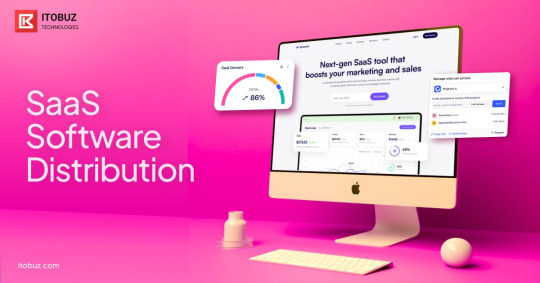
In this article, we will explore the various distribution models for Software-as-a-Service (SaaS) products. As a leading provider of SaaS solutions, we understand the importance of creating exceptional software and effectively delivering it to our valued customers. To achieve this, it is crucial to have a well-defined and efficient distribution strategy. This comprehensive guide will delve into the different methods of distributing SaaS software and how to optimize them for maximum reach and success.
The distribution of SaaS software is a critical aspect that can significantly impact the success of a product. A well-executed distribution strategy ensures that our software reaches the right audience, expands our customer base, and drives revenue growth. In this article, we will explore several proven methods to effectively distribute SaaS software and how to leverage them to outrank other websites on search engines like Google.
SaaS Software Distribution Channels
1. Direct Sales Distribution

One of the most traditional methods of distributing SaaS software is through direct sales. In this model, we engage with potential customers directly, whether through email campaigns, cold calling, or personalized demonstrations. We present the benefits and features of our SaaS product, addressing the specific pain points of each potential customer.
To outrank competitors on search engines, we emphasize the importance of optimizing landing pages and product descriptions with relevant keywords. This optimization, coupled with compelling and persuasive copywriting, will enhance our website’s search engine visibility and drive more organic traffic.
2. Reseller Partnerships

Establishing reseller partnerships is another effective way to distribute SaaS software. By collaborating with third-party vendors and resellers, we can tap into their existing customer base and market presence. This strategic alliance allows us to extend the reach of our product and gain credibility through association with reputable partners.
For improved search rankings, we must create dedicated pages on our website for each reseller partnership. These pages should be optimized with targeted keywords, describing the partnership’s benefits and the value it brings to potential customers.
3. Online Marketplaces
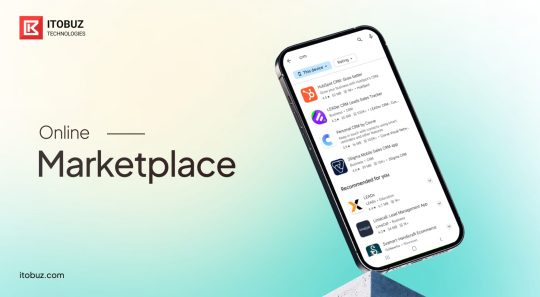
Online marketplaces have gained immense popularity in recent years as distribution channels for SaaS software. Marketplaces like the Apple App Store, Google Play Store, and popular platforms such as AWS Marketplace have vast user bases actively seeking software solutions.
To outperform competitors in these marketplaces, we should focus on creating engaging and informative product listings. Utilizing SEO-friendly titles, detailed product descriptions, and relevant tags will significantly enhance our product’s visibility and click-through rate.
4. Freemium Models
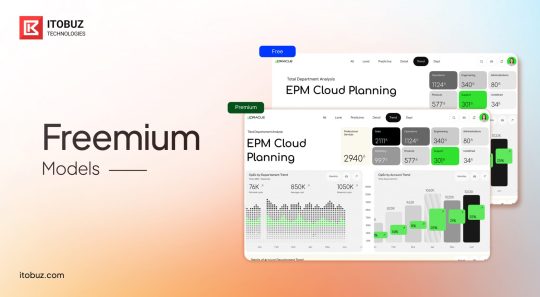
Offering a freemium model can be a powerful strategy to attract potential customers and showcase the value of our SaaS software. In a freemium model, we provide a basic version of the software for free, allowing users to experience its core features before deciding to upgrade to a premium, paid version.
To stand out from competitors and rank higher on search engines, we should optimize our landing pages for freemium offerings. Highlighting the benefits of the free version and the added value of the premium version will drive more organic traffic to our website.
5. Integrations and APIs
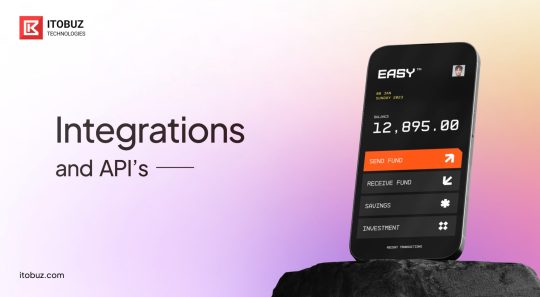
Integrations and APIs (Application Programming Interfaces) play a crucial role in the distribution of SaaS software. By seamlessly integrating our product with popular third-party applications and platforms, we can tap into their user bases and gain a competitive advantage.
For better search engine rankings, we should create detailed documentation and resources for developers interested in using our APIs. By doing so, we enhance the chances of appearing in relevant search results and attracting developers eager to work with our software.
6. Referral Programs
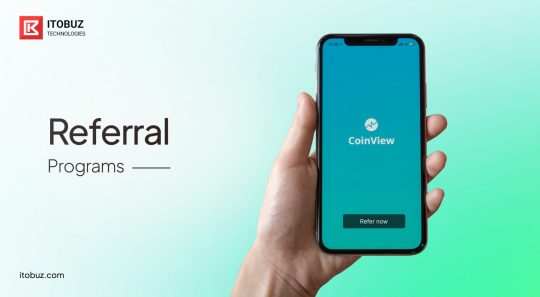
Referral programs can be a highly effective way to encourage word-of-mouth marketing and expand our customer base. By incentivizing existing customers to refer our SaaS software to others, we can create a self-sustaining distribution channel.
To boost our referral program’s visibility, we should create a dedicated page on our website, optimized with keywords related to referrals and rewards. Additionally, providing engaging content and promotional materials to our customers will increase the likelihood of them participating in the program.
7. Mobile App Stores
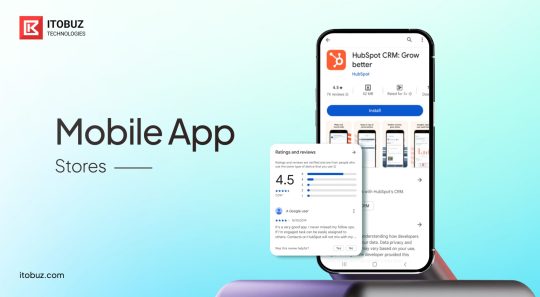
For SaaS software with a mobile component, distributing through mobile app stores is essential. Users frequently search these platforms for apps that meet their specific needs, presenting an excellent opportunity for us to reach potential customers.
To optimize our presence in mobile app stores, we should focus on writing compelling app descriptions with relevant keywords. Regularly updating our app with new features and improvements will also positively impact our rankings on these platforms.
8. Maximizing Distribution Impact
To maximize the impact of our SaaS software distribution, we should consider a multi-channel approach. Combining various distribution methods can broaden our reach and attract different segments of potential customers.
Additionally, we must continuously monitor and analyze the performance of each distribution channel. By tracking metrics such as conversion rates, click-through rates, and customer feedback, we can refine our strategies and optimize the channels that yield the best results.
Conclusion
In conclusion, effective distribution is the backbone of a successful SaaS software business. By employing direct sales, reseller partnerships, online marketplaces, freemium models, integrations, referral programs, and mobile app stores, we can significantly expand our customer base and drive revenue growth.
To outrank competitors on search engines like Google, we must adopt a strategic approach to SEO. Optimizing landing pages, product descriptions, and dedicated partnership pages with relevant keywords will improve our website’s visibility and organic traffic.
Remember, distribution is not a one-size-fits-all solution. We should continually experiment, analyze data, and adapt our distribution strategy to the ever-changing market landscape. By doing so, we position ourselves as industry leaders and drive the success of our SaaS software in a highly competitive digital landscape.
Want to know more about this topic or other related topics visit our Blog Page
Want to develop SaaS Software for your business visit our website page SaaS Application Development Services
#saas software#saascompany#saas solutions#saas app development company#saas technology#softwaredevelopment#b2b saas#saasmarketing
0 notes
Text
Critical Role of Software Development in The Energy Transition

The global energy transition from fossil fuels to alternative, eco-friendly energy sources is one of the most pressing challenges of our generation. To ramp up the decarbonization of their energy systems, over 70 countries have made ambitious commitments to achieve net-zero emissions by 2030. In the private sector, over 50% of Fortune 500 companies have made similar, net-zero commitments.
Are these ambitious, lofty and unrealistic? Maybe. But, thankfully both the private and public sectors have a strong ally in this war against climate change: software engineering energy. That is right, efficient software engineering is set to play an all-critical role in the global energy transition. To understand why, you need to understand how most energy grids work.
How Software Development Can Help in The Energy Transition

The “grid,” i.e., our electricity infrastructure, is probably one of the most complicated pieces of machinery ever created by humans.
Historically, electricity would be generated in large coal or gas-fueled power stations.
This electricity would then be fed into wires that transfer high-voltage electricity to substations.
At the substations, transformers diminish the voltage, and the electricity is carried to distribution substations.
At the distribution substations, the voltage is diminished again. From there, the electricity is sent along wires to smaller transformers.
These smaller transformers diminish the voltage again before the electricity is finally transmitted to homes and businesses.
Almost every modern-day electrical grid in the world has this plethora of intricate, interconnected parts. Sounds super complex, right? Well, the global energy transition is set to make the traditional energy grid system, even more complex.
Old-school energy grids were based on centralized power plants where fossil fuels were used to generate electricity. In the past 100 years, this system became relatively simple and easy to manage for engineers.
Now, electrical engineers have to deal with alternative, non-fossil-fuel-based energy sources like solar panels or wind farms, everywhere along the grid. These “intermittent energy sources” only generate energy when the sun is shining or the winds are blowing.
Why is that a bad thing? Well, there is one important characteristic of the traditional energy grid that has remained the same for the past 100 years: Supply Must Meet Demand. Whenever this does not happen, the whole grid fails.
In the previous paragraph, we referred to renewable energy sources as “intermittent,” because they do not generate electricity all the time. When such energy sources are connected to a traditional grid, balancing demand and supply in real time, becomes challenging.
That is where software engineering can help. software today can tap into publicly-available data and proprietary data from utility companies to create a real-time digital map of a grid system. Such a digital grid map can help identify potential trouble spots in the grid.
For example, according to a new study, at least 85% of the global population has been exposed to extreme weather events in recent years.
Raging fires, powerful winds, and other types of extreme weather events can severely damage an energy grid. Such events can disrupt the flow of electricity to critical infrastructure like hospitals.
A smarter, software-powered grid that can predict such dangers in advance can also respond more spontaneously to extreme weather events.
A well-designed, software-powered grid of the future can help humans avert energy emergencies caused by extreme weather events. There are many such renewable energy software solutions that currently exist but are not implemented at utilities across the US and the globe. If more utility providers adopt such solutions, they will be able to eliminate the risk of grid instability.
The more reliable and resilient a grid, the less energy it will waste. More importantly, the software can accelerate the transition from traditional, fossil fuel-based energy grids to complex energy grids that feature multiple sustainable energy sources.
How Software is Already Facilitating the Energy Transition

The use of software in the global energy transition is nothing new. In the 21st century, several different types of software engineering efforts have positively impacted the energy sector. Here are some of the most prominent examples:
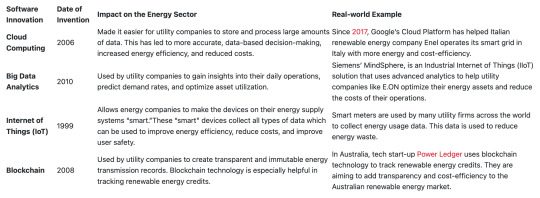
These are just a few of the major innovations in software engineering that have positively impacted the energy sector in the past ten years. As these technologies become more and more refined, we can expect to see even more applications in the years to come. There is another sector of software engineering that has the potential to transform the energy sector that we did not mention in this chart: AI.
Applications of AI for the Global Energy Transition

Artificial Intelligence (AI) is a rapidly expanding field that is set to play a huge role in global energy transition efforts. AI’s impact on the energy sector is set to be so big that we had to dedicate a section of this article to AI. Here is a brief list of ways AI can aid in the global energy transition:
AI-powered tools can be used in solar and wind farms to identify locations with the most favorable sun/wind resources.
AI-powered equipment delivery systems and worksite monitoring tools can accelerate the rate at which eco-friendly power plants are constructed.
AI-powered tools can be used to predict failures and outages at power plants. Similar tools can be used to create maintenance schedules for power plant equipment.
AI tools can also be used to optimize electricity consumption at the individual user level. For example, AI-powered equipment tracking tools can reduce the amount of power people consume on a day-to-day basis.
AI-powered prediction of wind/solar outputs can help engineers better predict future supply problems.
These are just a few ways AI engineering can help the energy sector in the upcoming decade. As the quality of AI-powered tools improves, we can expect to see even cooler applications of AI in the energy sector in the years to come.
Final Take
Climate change is the most existential risk that our generation currently faces. The need for decarbonisation has never been more urgent. More software engineers need to enter the energy sector because as you can see from the examples mentioned above: they have a huge role to play in the battle against climate change.
Want to know more about this topic or other related topics visit our Blog Page
Want to develop a Renewable energy Management Software for your business visit our page
#renewableenergy#renewable energy solutions#energy solutions#renewable transition#renewable energy software development
0 notes
Text
Hybrid Vs Native App Development Difference (2023)

The COVID-19 pandemic forced a major shift in consumer behavior towards mobile apps, and this shift seems to be permanent. In the last two years, the average time spent on mobile apps has increased by over 50% and consumers in over a dozen markets worldwide are spending at least 5 hours a day using mobile apps. In 2023, the global network of mobile apps is set to generate over $526 billion in revenue. To keep up with this cataclysmic shift, businesses of all sizes are being forced to enter the lucrative world of apps as fast as possible. Hybrid vs Native App Development Difference naturally plays a crucial role in determining the approach businesses should take when venturing into the mobile app domain.
Investing in App Development
In the post-pandemic world, millions of businesses across the world have jumped onto the bandwagon of investing in custom app development. Unfortunately, many are failing horribly. The main reason behind their failures is their inability to identify the type of app they need to build to best suit their target users’ needs.
When businesses are unable to perform this key function, they fail to give correct briefings to their app development teams. The result is a laundry list of apps that do not deliver the expected results. How can this fundamental error be corrected? Before investing a cent into app development, business leaders first need to decide a few things:
What kind of mobile apps do they want to develop for their target users?
Which devices do they want to launch their apps on (mobiles, wearable tech, tabs)?
Which type of device OS (operating system) their respective IT environments are prepared to support?
The two main mobile OS platforms in the world are Google’s Android & Apple’s iOS. So, ultimately all three of these decisions boil down to one simple question. Which type of mobile app development do you want to invest in, native or hybrid?
What’s the difference between native and hybrid app development and why is it so important for app makers to choose either? Let’s compare both native vs hybrid app development practices in detail to answer these questions.
Hybrid Vs Native App Development Difference – Let’s Discuss
What is Native App Development?

A native app is a smartphone app developed explicitly for a specific mobile operating system. For example, Instagram was initially developed as a native app only for iOS in 2010. It was later acquired by Facebook in 2013 and only then it became a hybrid app that was available on both iOS and Android devices. Other examples of hybrid apps that started off as native apps include Uber, LinkedIn, Twitter, and Airbnb. These apps were developed within mature ecosystems.
They were built per the technical and user-experience guidelines of their native operating systems. That’s why, in these apps, in-app interactions are typically smoother and they feel more consistent. Native apps are also designed to access and use the devices’ built-in features like GPS, camera, etc. On top of that, native apps are designed to fit the screen of their native devices.
All of these elements make well-designed native apps highly enjoyable to use. However, native app development comes with major restrictions. For e.g., investing in iOS native app development means that your app will only work on Apple devices and not on Android devices. Most iOS apps are developed using Swift-C & Objective whereas JavaScript, HTML5, or CSS are used for developing most Android apps.
If you’ve invested exclusively in iOS native app development, you only have access to Swift-C & Objective developers. If you want your app to appear on billions of Android devices across the world, you’ll need to invest in separate Android-native app development. Sounds expensive and time-consuming, right? Well, you can simply avoid these problems by investing in hybrid app development from the start.
What are Hybrid Apps?

A hybrid app is an app built using simple web frameworks like JavaScript, HTML5, or CSS. This app can then get packaged into a native app using a framework like Ionic or Apache. HTML5 and JavaScript are basic web development tools and at their core hybrid apps are websites wrapped in native app containers. Hybrid app development has become extremely popular in recent years, thanks to the never-ending demand for business apps.
For app developers, creating apps for multiple app markets using a single unified codebase and a simple programming language like HTML5 or CSS is a much easier prospect than developing an Android-only app using Java. It’s also a much less expensive prospect. Why write code for apps that are limited to just one market when you can target multiple markets by taking the hybrid route? Consider the following example:
To build iOS apps, a developer has to be proficient at using Swift-C & Objective. In the US, the average iOS developer’s salary is over $145,000/year.
In comparison, a full-stack web developer who is proficient in programming languages like HTML, CSS, and JavaScript earns an average of $67,174/year.
Hybrid apps are cheaper to build. With the right developers, businesses can combine different elements from other mobile app development techniques and create high-quality hybrid apps that meet their target users’ needs both on iOS and Android. However, not all businesses get this mix right.
A major flaw of hybrid apps in general is that they don’t always look and function well on all platforms. To create apps for multiple platforms, developers need to have a deep understanding of the difference between native and hybrid app development environments. They also need to learn the subtle differences between designing and testing iOS and Android apps. Only then can they achieve what they set out to achieve by selecting hybrid app development over native at the start: minimizing development time, resources, & effort.
So, how difficult is it for developers to master the art of creating HTML5 or CSS web apps and then scaling them for different markets? Let’s take an example of some of the best app developers in the world at Meta (formerly known as Facebook).
According to the company’s CEO Mark Zuckerberg, one of the biggest mistakes in his company’s early history was focusing too much on HTML5 apps and too less on the native apps.
Since then, Zuckerberg has corrected his company’s app development course by investing heavily in native iOS and Android apps.
If Meta can get it wrong, any company can get it wrong. But, what about the companies that need to scale? What about the brands that want to target multiple app markets for a lesser price? According to recent estimates, native app development projects that target either the Android or iOS market cost $40,000 to $1,00,000+ on average.
In comparison, a hybrid approach costs only $20,000 to $60,000+. Should businesses target more platforms for a lesser price or should they invest in native apps that allow users to enjoy the full functionalities of their smart devices? To answer this question, let’s compare the PROS and CONS of native vs hybrid app development.

Pros of Native Mobile App Development
Standardized Development Kits
Native app developers have easy access to a variety of standardized app development kits. These kits contain all UI components/elements that are specific to the native approach in question. For instance, if you’re building an Android-specific app, you’ll find many standardized Java kits that include all UI elements of standard Android apps.
Access to Native Device Features
Native apps can easily access and utilize built-in device features like the camera, GPS navigation, etc. They’re designed to increase interactivity between different features on devices.
Memorable user experiences
Native apps tend to run faster as they’re built to suit device parameters accurately.
Faster approvals
Native apps get published at faster speeds because they’re designed to meet the specific design guidelines of specific app environments.
Cons of Native Mobile App Development
Each new platform requires additional costs for app maintenance, updates, etc.
Native apps carry a higher burden of passing the verification stages on app store platforms.
It is very hard to create consistent versions of native apps for other platforms. If app updates aren’t synchronized on time, users of the app on a specific platform may experience glitches, support problems, etc.
Needs investments in API development.
Pros of Hybrid Mobile App Development

Cutting development time short.
No heavy burden of meeting strict app store regulations.
Doesn’t require high-level knowledge from programmers.
Hiring hybrid app developers is much easier and cheaper than hiring native app developers.
No need to invest in API development as it’s all conducted via the web.
Since only one piece of code is created to make the app function on multiple platforms, managing, updating, and improving the app is much easier.
Cons of Hybrid Mobile App Development
Hybrid app developers target multiple app markets by building additional layers between the platforms and their source codes. Hence, hybrid apps often deliver poor performances on one or more platforms.
Limited native functionality. Hybrid apps don’t have access to all the native features in devices (camera, GPS, etc.)
Hybrid apps are more likely to experience speed problems.
Hybrid apps do not support offline mode.
Once a hybrid app is developed, scaling it for additional devices is very hard. The more app markets you want to target, the costlier the project will become.
Native Vs Hybrid App Development: Choosing One of the Two
When we compare the advantages and disadvantages of native vs hybrid app development, the difference between native and hybrid app development is quite apparent. That’s why the native vs hybrid app development discussion is still relevant in 2023. Choosing a hybrid approach will certainly save your company time, money, and effort in the short term.
Speed-to-market, unified source code, easy updates, & cross-compatible web technologies: these factors, coupled with the lower costs, make hybrid app development seem very appealing. But, in the long run, most hybrid app developers have to work extra hard to address user complaints from multiple app markets by fixing the bugs/glitches in their apps.
Are you ready to take on such risks? Then, go hybrid. If not, stick to native app development and focus on delivering unforgettable user experiences, not the bottom line. Whichever one you choose, always be cognizant of the trade-offs that come with both these app development approaches.
Want to know more about this topic or other related topics visit our Blog Page
#hybrid app development#native app development company#app development#mobile app developers#mobile app development
0 notes
Text
15 Mobile App Development Trends in 2023
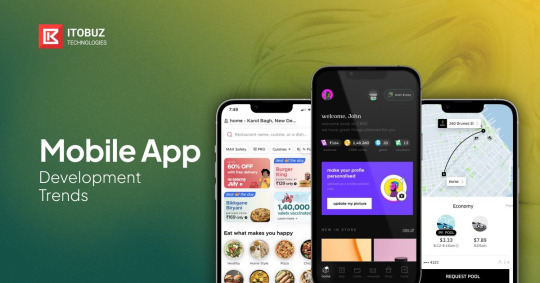
The 15+-year-old mobile app development economy keeps evolving every year as changing user behaviors & the rise of new technologies keep posing new challenges for app developers. But there is something that hasn’t changed in quite a while: the mobile app development industry’s significance in the global economy. Approximately 435,000+ apps are downloaded across the world per day. Many of these apps are essential contributors to the GDPs of their native countries. For instance:
In China, the mobile app industry generated 5.5% of China’s GDP, adding $1.1 trillion of value to the country’s economy. As of 2022, 35% of all the money spent on mobile apps in the world comes from China.
Things are similar in North America where approximately 4.2% of the continent’s GDP is generated by the mobile app industry. That’s over $1 trillion. Approximately 84% of the population pays for at least one mobile app in North America. The mobile app industry there support over 2.2 million jobs.
India is expected to become the world’s largest app developer population center by 2024. The country’s mobile app industry currently employs over 1.7 million professionals. This figure will grow sharply over the next decade as India’s app market is expected to grow at a CAGR of 9.2% between 2023 & 2026.
Other major countries like Japan, South Korea, the UK, Germany, Brazil, Nigeria, & Mexico also have booming mobile app industries. These industries don’t seem to be slowing down any time soon. The global mobile app industry is expected to grow at a CAGR of 8.58% between now and 2027. Certain trends are set to drive this growth. In this article, we’ll discuss the top 15 mobile app development trends in 2023 that will shape the future of this vibrant and ever-expanding industry:
Top 15 Mobile App Development Trends
1. Increased Integration of AI and Machine Learning Technologies

It’s impossible to create any list in 2023 without mentioning the terms “AI” & “ML” and rightfully so. According to recent estimates, between 2022 & 2030, the global AI market is expected to grow at an uber-impressive CAGR of 38.1%. Mobile app developers will play a key role in this growth. The use of AI and machine learning (ML) in mobile app development is already quite prevalent.
Google Translate uses ML to instantly translate text in 100+ languages.
Spotify uses ML to assess user history & recommend appropriate music.
Uber uses AI to optimize driver routes in real time.
All the top app development companies already use AI & ML technologies and this trend will only continue beyond 2023. More and more developers will be enticed to integrate ML & AI into their mobile apps because their apps collect tons of data. Collecting & training AI & ML models is also much easier today for mobile app developers thanks to the development of open-source AI/ML tools & the general growth of the AI & ML community in recent years. Automated reasoning, personalized interactions, and a better understanding of how users behave on the app are the three key qualities app developers can add to their apps by adopting AI & ML technologies.
2. Low-No-Code Mobile App Development
In 2019, Gartner predicted that by 2024, 65% of mobile application development projects will happen on low-no-code platforms. Were they right? Well, the global no-code/low-code platform market went from being valued at $3.4 billion in 2019 to $8 billion in 2022 at a rate of $1+ billion per year. So, yes Gartner’s prediction is still on track to be correct. Low-no-code platforms feature easy-to-use, drag-and-drop visual tools.
Even non-developers can create tens of thousands of lines of code on these platforms to build new apps. Why is that important? Well, according to the International Data Corporation (IDC), by 2025, there will be a global deficit of 4+ million developers. Mobile app development companies know that low-no-code platforms allow their non-technical workers to meaningfully contribute to the development process. These platforms can also reduce app development time by up to 90%.
Here are some other benefits of using low-code/no-code technologies compared to traditional app-building platforLow-no-code tools have the potential to be ten times faster than their traditional counterparts.ms:FeatureLow-No-Code Mobile App DevelopmentTraditional Mobile App DevelopmentCostLess expensive. According to a recent study, low-no-code platforms can help the average company avoid hiring at least two software developers & save over $4.4 million over three years.Considerably more expensive.Time-To-MarketLow-no-code tools have the potential to be ten times faster than their traditional counterparts.Traditional development platforms are less agile. They feature complex codes which require a lot of time to master.Technical Expertise RequiredLess technical expertise required. In a recent survey involving non-technical workers, 85% of them claimed that using workers using low-no-code tools helped them add value to their organizations.High technical expertise necessary.FlexibilityLess flexibleMore flexible, especially for mobile app developers with high technical expertiseCustomizationDifficult to customize, especially on platforms with limited featuresMore customizableSecurityComes with fewer security integration optionsCan be made more secure through customized security integrations
As you can see from the last three rows, low-no-code platforms aren’t perfect. They’re not designed to eliminate the need for traditional mobile app development practices either. But, more & more mobile app developers will use them over the next decade because they offer way too many benefits.
3. Increased Adoption of Cloud Technology

Cloud technology has transformed the way mobile applications are developed, deployed, and maintained. Mobile app developers who use cloud-based services don’t create traditional native apps: they create cloud-based apps. Scaling these apps (up/down) to meet the demands of a growing/shrinking user base is super easy.
Doing the same with native apps is impossible Cloud-based apps don’t need to depend on user devices or platforms to operate effectively. As long as the user has a working internet connection, cloud-based apps will always be available. These are the reasons why mobile app developers are set to further solidify their interest in cloud-based services in 2023.
4. The Rise of the Super-App
Elon Musk recently claimed that he wants to transform Twitter into a “super-app” called “X.” What’s a super-app you ask? A super-app is an all-in-one mobile app that handles all of a user’s day-to-day requirements via one unified interface. Imagine doing everything, from social networking to banking to paying your bills on one app. That’s the reality that super-app developers like Mind Inventory, Alibaba Cloud, & Appinventiv are planning to build over the next decade.
According to some reports, the number of times mobile app developers mention the word “super-app” in their quarterly earnings calls has increased by almost 500% since 2018. More major industry players like Meta, Snapchat, Microsoft, etc., will invest heavily into super-app ecosystems throughout 2023.
5. Gamification

Back in the day, the thrill of gaming could only be felt on gaming apps. In 2023:
eCommerce apps like AliExpress, Shein, Nike, Walmart, etc., use gamification elements, such as in-app bonus games, daily check-in rewards, etc. to engage users.
Productivity apps like Habitica, Todoist, etc., use gamification to encourage users to complete their daily tasks.
Learning apps like Duolingo and Khan Academy use gamification elements like levels, winning streaks, rewards, etc. to make educational content more enjoyable.
Fitness apps like Nike Training Club use point & reward systems to encourage users to meet their fitness goals
There are thousands of other examples and the list will only continue to grow in 2023. Blurring the line between a standard app and a game gives mobile app developers the space they need to create more engaging and immersive user experiences.
6. Integration of Mobile Apps with Other Smart Devices
Mobile apps may leap beyond the world of mobiles & find new spots inside smart home devices, wearables, and other connected devices. In 2023, many mobile apps will be re-touched & re-launched on smart security systems, smart cleaning devices, and other smart devices that aren’t mobile phones.
7. PWA Army
For brands that want to provide seamless user experiences across all platforms/devices, building multi-platform PWAs from a single codebase is still the best option. PWAs, i.e., progressive web apps are web-based apps that took the mobile app development industry by storm in the early 2010s. 13 years later, the hype behind these apps is far from dying.
8. Non-Stop Customization
Cloud-based apps & PWAs are very updated and friendly. That’s why savvy mobile app developers constantly re-customize and re-personalize their apps, based on the user data they collect. This relentless customization makes their apps more engaging & user-friendly over time.
9. Incredible Advancements in UX and UI Design
There’s too much happening in the world of mobile app UX and UI design in 2023. Some of the most notable trends include:
Scrollytelling: Scroll through stories featuring high-quality graphics and 3D elements to get immersive experiences. This form of UX design is called “scrollytelling.”
Buttonless UIs: Many apps are experimenting with UI designs that feature no buttons and solely rely on voice commands or hand gestures.
Real-Time Customized Digital Illustrations: This UI design trick leverages AI tools to produce customized illustrations and graphics for users.
Neomorphism: This visually compelling UI design style is known for its realistic, tactile feel. Mobile apps like Tesla, Spotify, and many more feature neo-morphic UI designs.

Figure 1 Example of Neomorphism in UI design
10. Apps for Foldable Devices
The global foldable smartphone market is growing at an incredible rate. According to a study from Counterpoint Research, only 2.8 million foldable smartphones were shipped in 2019. In 2022, that number crossed 16 million. Many app developers are creating apps specifically for users of foldable devices like the Motorola Razor or the Samsung Galaxy Fold.
11. 5G Momentum Continues to Grow
The rollout of 5G across different parts of the world over the next four years will have a drastic impact on mobile app developers. According to Statista, the number of 5G connections in the world increased by 3.5 times between 2021-22. That number doubled again between 2022-23.
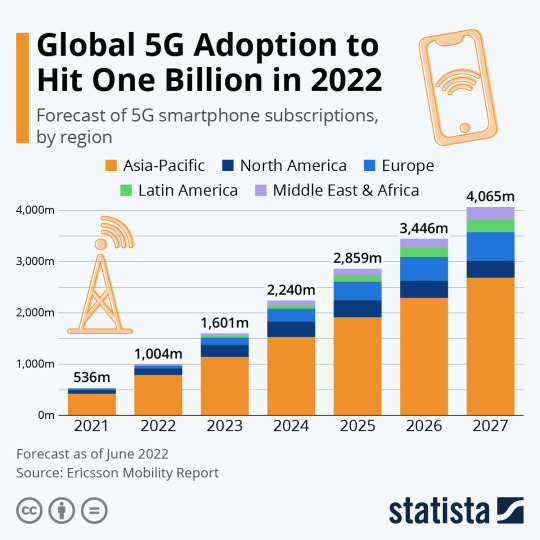
Here are some ways these developments will impact mobile app development: Load speed on apps will drastically improve. Developers will have more leeway to incorporate heavier design or functional elements into their apps. Developers must use 5G speeds to test their apps pre-launch. Improvements in connection density will enable more phones to connect to one network simultaneously, meaning developers can now create apps that can facilitate more users.
12. More Connectivity with Wearables
Many smartwatches, health trackers, fitness bands, and other apps already come with their mobile apps. In 2023, more independent apps will be built specifically for these wearables. Many will feature AI-powered features.
13. Beacon Technology

A beacon is a clever marketing tool that app developers have been using since 2013. Beakers are devices that retailers install inside their stores. A beaker will automatically connect to any device that contains the retailer’s mobile app. This automatic connection via Bluetooth can be used by the retailer in many different ways. Beacon technology will continue to be embraced by more industries in 2023.
14. eCommerce
Every business is leveraging mobile apps to boost their revenue streams. So, needless to say, much of the mobile app development world will be focused on catering to these needs in 2023.
15. Superior Security
In early 2022, there was a huge surge in mobile malware attacks across the world. Thankfully, since then many app developers have implemented stricter security measures. Some of these measures include:
Writing secure code that’s hard to reverse-engineer
Encrypting all data exchanged over the app
Regularly making security updates to the app
Implementing stronger authentication systems such as two-factor authentication
Validating all user inputs and sanitizing all data transferred to other systems
There you have it: a comprehensive outlook on all the hottest trends in the ever-changing world of mobile app development. The best mobile app developers in the world are gearing up to stay ahead of these trends in 2023. Use this guide to outdo them!
Want to know more about this topic or other related topics visit our Blog Page
#app development#mobile app design#mobile app development#mobile app developers#mobile app trends#design trends
0 notes
Text
What are the best practices while developing a SaaS Application in 2023?
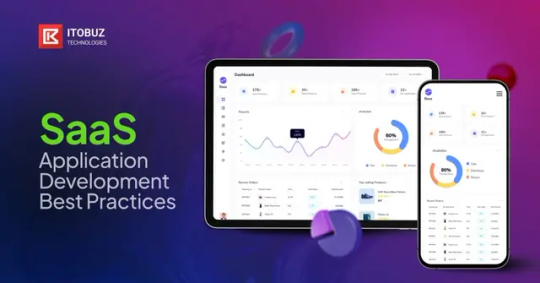
Practice #1. Choosing the Right SaaS Architecture Design
Right at the start of your company’s venture into SaaS application development, you will have to decide what type of SaaS Architecture you need based on the specific needs of your app. The term “SaaS architecture” refers to the process in which SaaS apps are designed and deployed by SaaS providers. There are two popular types of SaaS architecture to choose from:
●Single-Tenant
●Multi-Tenant
To decide which type of SaaS architecture is right for your project, consider the following factors:
Budget: Multi-tenant providers are typically cheaper.
Project Needs: If your project needs cost-effectiveness and scalability then a multi-tenant SaaS architecture is a better fit. If it needs data security, then single-tenant is the better option.
Compliance Requirements: SaaS apps that have to comply with extremely strict data security regulations are better off being managed by single-tenant SaaS providers.
Practice #2. Selecting the Right Methodology
SaaS providers and software engineers in general use different methodologies to maximize productivity, save time, and simplify collaboration within the team. Before SaaS app development starts, companies and their SaaS providers must select a methodology that suits their strengths and supports their business needs. The most popular methodologies for SaaS application development are Agile, Iterative, and Rapid.
Practice # 3: Onboarding the Right Pros
Once you decide which methodology to follow, you will need to ensure that the right experts are in your development team. The number of members in different teams will vary, based on the project scope/size
Practice #4. Road-Mapping The SaaS Application
Solution architects, product owners, and managers should assist in the application “road-mapping” process. This process clarifies “Who” is doing the developing work for “What” target audience and “Why.” In other words, a SaaS roadmap will define your short/long-term SaaS product goals.
Here is a simple way of creating a roadmap for your SaaS app:
Define the objectives you want your SaaS app to achieve and prepare clear-cut development strategies to attain them.
Choose a development methodology.
Choose the right SaaS architecture.
Gather inputs from all team members for internal product road mapping and stakeholders for external road mapping (including real users).
Create a workflow and allocate necessary resources.
Decide on deadlines and budgets for prototypes.
Create a user journey map detailing user needs and pain points.
Create a User Interface (UI) design strategy.
Create a User Experience (UX) strategy.
Create plans to develop the backend and the front end.
Following this roadmap step-by-step will allow you to rapidly create, test, and improve prototypes until you get the final, ultra-refined version of your app.
Practice #5. Choosing the Right Tech Stack for Your SaaS Application
A tech stack is a collection of technologies, frameworks, and tools used to build SaaS applications. The tech stack you choose will determine which technologies, frameworks, programming languages, databases, and APIs are used to build the front-end and back-end sections of your SaaS application.
As you can see each layer of a SaaS app is built on top of each other to form a “stack.” Your choice of tech stack will have major downstream effects on how you build the app, the types of pros you hire, and the types of integrations you can make to your app. Most new-age SaaS providers have expertise in specific tech stacks.
So, your decision regarding which tech stack you will use to build your app will be probably made by your SaaS provider. Still, it is important to know your choices and communicate your preferences to your SaaS provider. Here is a chart detailing all the tech stacks you can choose from for your SaaS application development project:

The column “Requirement” in the chart above indicates its core usability. For example, if you have to select a tech stack for building single-page SaaS apps, then Angular, React, and Svelte, would be good options.
Bear in mind: this is just a selection of some of the most popular tech stacks around today. There are other options available.
Choose on the basis of your project needs and requirements. A top SaaS provider can even mix and match different technologies from these tech stacks to create a custom tech stack for your app.
Practice # 6: Constantly Testing App Potential through MVP

The earlier you build an MVP (Minimum Viable Product) of your app, the faster you will be able to refine it. An MVP is the very first iteration of your app. It should be tested and refined accordingly to create more iterations. The best SaaS app developers in the world, practice the following steps to optimize their development processes:
Building an MVP
Testing
Launch
Feedback gathering
Relaunch
Wrapping Up
SaaS apps represent the largest segment of the cloud market in terms of user-spending in 2023. This market will be valued at $197 billion by the end of this year according to Gartner. Building a scalable, user-friendly, and robust SaaS app can transform the fortunes of any business/brand. Use this guide to understand the key concepts and practices behind the SaaS application development process!
Want to know more about this topic or other related topics visit our Blog Page
If you need a SaaS Software for your business visit our website page SaaS Application Development
#saascompany#saas solutions#saasmarketing#saas app development company#app development#saas software
1 note
·
View note